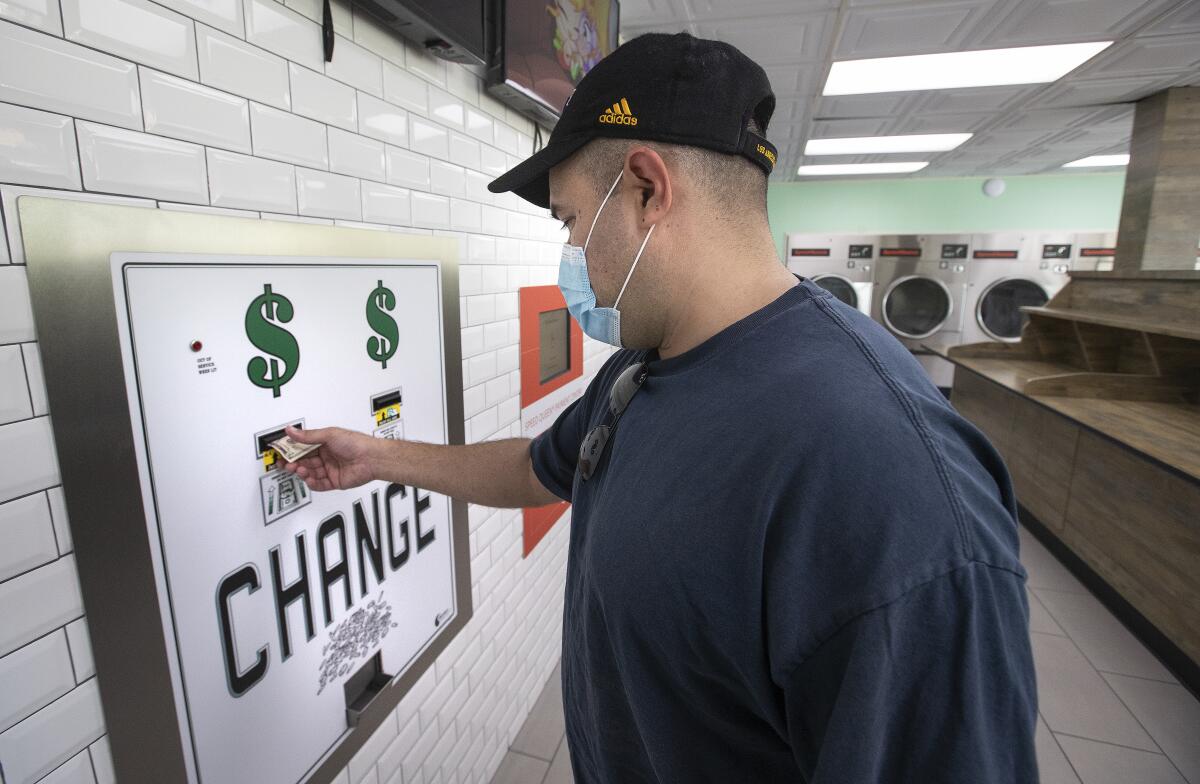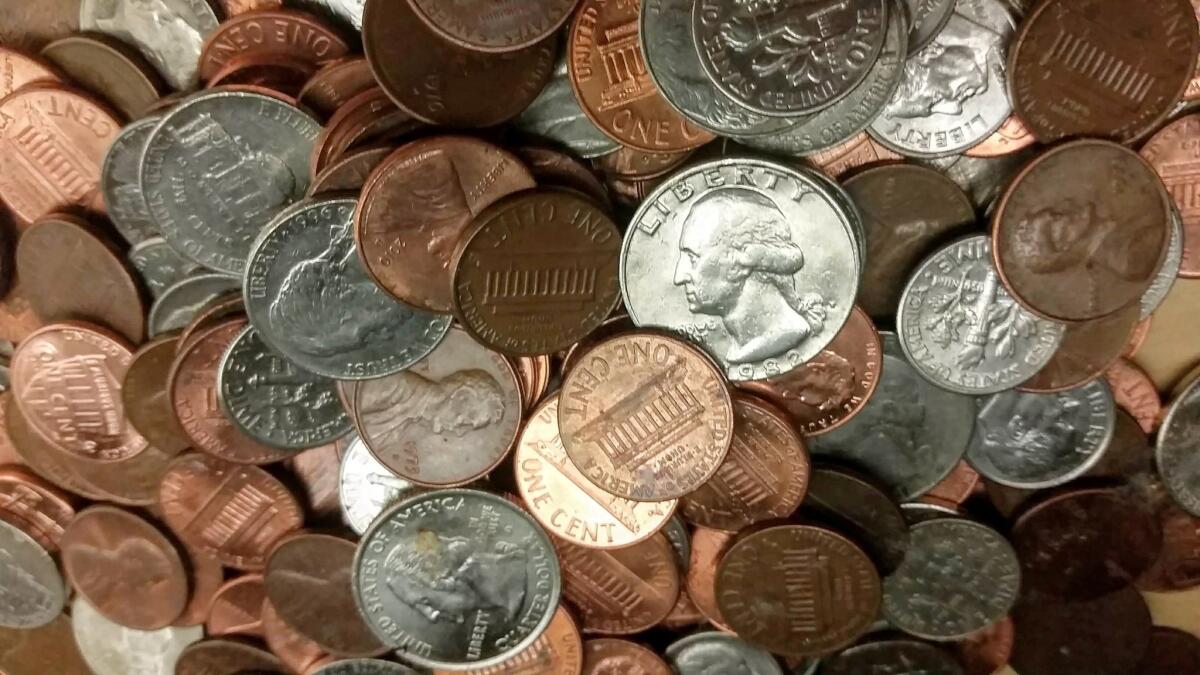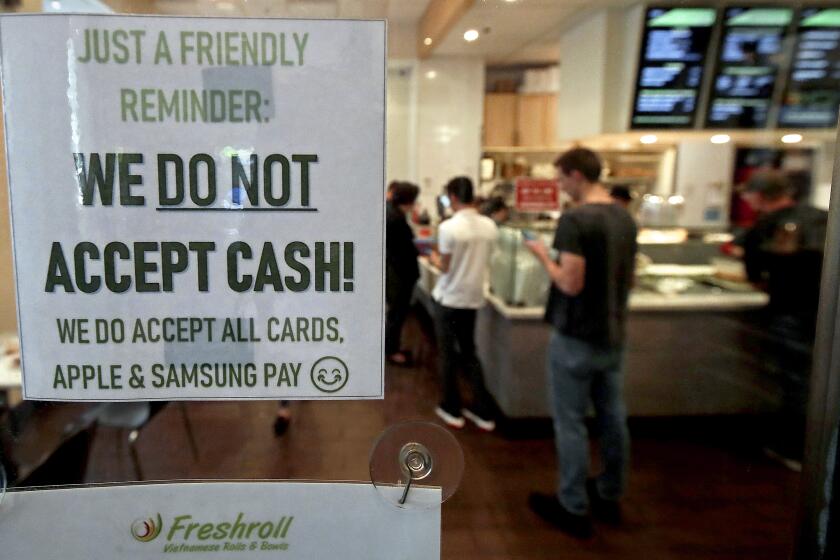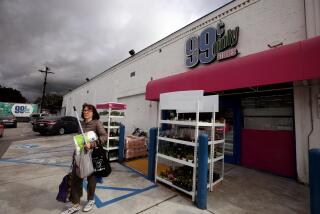Free drinks, store credit and cries for help: How we’re handling the coin shortage

- Share via
A laundromat operator imploring friends and relatives to trade their stashes of quarters for his dollar bills. A restaurant offering customers free drinks instead of nickels and dimes. Supermarkets issuing pennies’ worth of store credit. A woman filling her purse with coins so she can pay in exact change.
The COVID-19 pandemic has caused a coin shortage, and it’s hitting small-business owners, big retailers and everyday shoppers — especially those who don’t have credit or debit cards — in ways big and small.
The main way coins circulate through the economy is via store transactions and coin recyclers, according to the U.S. Mint. But as the coronavirus spread, stores closed and visits to essential retailers plunged.
That means coins are stuck inside people’s homes.
Coinstar felt the trend begin. The Bellevue, Wash., coin-cashing company operates more than 17,000 kiosks throughout the U.S., the vast majority of which are in grocery stores.
In April, transactions at Coinstar kiosks decreased “more than a few percent” compared with their normal volumes, Chief Executive Jim Gaherity said in an interview this month. Over time, the transaction rates started to slowly climb back, though the demand for coins “is still far and away beyond what the supply is out there,” he said.
When stores need coins, they turn to banks. If the request is more than what the bank has on hand, it can relay that order up the supply chain to the Federal Reserve, the U.S. Treasury and, finally, the U.S. Mint. But when one part of the chain is disrupted, it slows the entire process.
“You had a breakdown in the system because of the closing of the stores and banks,” said Douglas Mudd, curator and museum director of the American Numismatic Assn.’s Edward C. Rochette Money Museum in Colorado Springs, Colo. “And when it started up again, there was a bit of an overdemand.”
One part of the solution: making more coins. The Mint said it has been operating at full production capacity since mid-June and is on track to mint 1.65 billion coins a month for the rest of the year. Last year, the Mint produced about 1 billion coins a month.
But newly minted coins made up only about 17% of the coins in circulation last year, according to the Mint. The rest comes into the supply chain from third-party coin processors and stores.

The Mint has urged people to start spending their coins, deposit them at banks or take them to a coin redemption kiosk. “The coin supply problem can be solved with each of us doing our part,” it said in a statement.
Meanwhile, a number of retailers have shied away from accepting cash payments because they can’t make change.
But card payments are largely not an option for the millions of people in the U.S. who don’t have bank accounts.
In 2017, the Federal Deposit Insurance Corp. found that 6.5% of U.S. households were unbanked. That means 8.4 million U.S. households — home to 14.1 million adults and 6.4 million children — didn’t have a checking or savings account.
“Lower-income consumers tend to transact more in cash,” said Adrienne Harris, professor of practice at the University of Michigan and former special assistant to President Obama for economic policy. “It makes things harder for low-income consumers to get the very basic things they need.”
Even before the coin shortage, some businesses wary of handling cash during the coronavirus era were asking customers to use only card or contactless payment methods. That renewed debate over the merits and disadvantages of a so-called cashless society.
As we rush into a “cashless” society to slow the coronavirus, know that there are trade-offs. Businesses could make existing racial inequities worse.
Businesses with a lot of cash on their premises have higher insurance rates and must also make arrangements to deposit the money. But going cashless puts a swath of the population without bank accounts at an extreme disadvantage.
“If you strictly become a no-cash operation, then you begin to marginalize those people in the community because they just don’t have the same access to the instruments that everyone else has access to,” said Shelle Santana, assistant professor of marketing at Bentley University in Massachusetts.
The implications of the current coin shortage are similar to those of a cashless business but exacerbated because the shortage affects so many retailers.
“It’s a difference of degree, but a dramatic one,” Harris said.
Susie Shannon, executive director of Poverty Matters, a Los Angeles group that advocates for homeless people, said one of her clients has a lot of change saved up and now tries to carry a lot of it in her purse to pay in exact change because she doesn’t have a credit or debit card. Store credit is worthless if you don’t go back to that store to use it.
“Anything where you need coins in order to buy groceries, in order to do your laundry, it’s going to create a lot of stress among a population that’s already dealing with a lot,” she said. “It’s now become the norm that people have debit cards or credit cards.... A whole segment of our society is completely overlooked.”
During a recent shopping trip to a Smart & Final in the San Fernando Valley, Michael Knapp’s total bill came to $36.75. He paid $40 in cash, which he always uses because he doesn’t have a credit or debit card. He had hoped to get the change in quarters so he could use them to do laundry, but store employees told him they could not give him even one.
In the past, “quarters were always something you could find,” said Knapp, 64.
Knapp ended up getting the change in store credit. He said he’s not sure what he’ll do if the coin shortage continues. As for his laundry, he happened to wash a lot of clothes right before the shortage, so he’s OK — for now.
This isn’t the United States’ first coin shortage.
One notable one came during the Civil War, when Americans hoarded coins out of fear, as well as concerns about the value of newly introduced paper money, according to the publication Coin World. Congress then passed a law allowing people to use postage stamps as currency, which subsequently led to a run on post offices, said Rebecca Spang, professor of history at Indiana University, where she teaches courses on the history of money.
Stamps at the time had adhesive backs, making it more likely that they stuck together in a wallet. So months later, the U.S. government started printing what’s known as postal currency — a bill-shaped paper smaller than a business card that had an image of a stamp, along with the denomination.
That coin shortage lingered for decades, largely ending by the 1890s, Spang said. Others followed from time to time, including one in the 1960s caused by surges in demand.
The effect of the current coin shortage on businesses has varied. At a McDonald’s in Pomona, drive-through wait times have occasionally increased when employees have to take time to inform each customer that the restaurant is out of nickels. Kroger-owned grocery stores, including Ralphs and Food 4 Less, now give customers the option of loading change onto loyalty cards if no coins are available. They also invite customers to round up to the nearest dollar and donate the extra to charity.
Covina restaurant chain Taco Nazo is offering a free drink or bag of chips in lieu of change. The restaurants usually sell those items for more than a dollar.
“I’d rather the customer leave with a positive than a negative,” said Thelma Garcia, president of Taco Nazo Corp.
Businesses that are especially reliant on coins, such as laundromats and vending machines, face significant challenges. In a recent survey by the Coin Laundry Assn. trade group, about 60% of laundromat owners accepted coins as the only form of payment.
The shortage has started to cause “a little bit of panic,” said Brian Wallace, the trade group’s president. That’s spawned some creative workarounds — one of the group’s Iowa members drove to Nebraska to buy excess quarters from a friend.
Dan Marrazzo, president of Laundry Depot, a network of five laundromats in New Jersey and Pennsylvania, turned to family and friends for help, asking them to bring in extra quarters they had lying around in exchange for paper money.
And they delivered. Quarters quite literally rolled in, sometimes in 5-gallon water jugs that had to be carted in on a hand truck, or in 3-1/2-foot-tall banks shaped like Molson beer bottles. In the last two weeks, he amassed more than $4,000 in quarters.
“If we can’t make change, we can’t make money,” Wallace said. “And neighborhood residents can’t get clean clothes.”
A “good chunk” of the laundromats’ client base are the unbanked or underbanked households in the U.S., he said. “It’s easy to say, ‘Just use a credit card or just use a debit card.’ … Some people don’t have as much choice when it comes to how to pay for things beyond cash that others of us might have.”
Some laundromats are also trying to fend off neighboring business owners who come in and use the change machines to get coins for their own businesses.
Workers have been told to watch the change machines and make sure they’re being used only by patrons, said Brad Steinberg, co-president of PWS-the Laundry Co., which operates three laundromats and distributes laundry equipment. Recently, his South Gate company has seen increased demand by laundromats for installation of mobile pay or credit card options alongside the traditional coin slots.
Vending machine operators have been hit hard by the shortage too.
The majority of vending machines rely on cash transactions. If a machine doesn’t have enough change for a bill and the customer doesn’t have the right coins, they’ll leave, said Eric Dell, senior vice president of external affairs for the National Automatic Merchandising Assn. trade group.
A lost sale becomes even more crucial, considering the toll the pandemic has taken on vending machine use. Many are in workplaces that have become ghost towns as more people stay home.
One failed transaction “really has the potential to really impact future sales,” Dell said. If you go to a vending machine and it’s not a “user-friendly experience, you’re probably not going to go back.”
More to Read
Inside the business of entertainment
The Wide Shot brings you news, analysis and insights on everything from streaming wars to production — and what it all means for the future.
You may occasionally receive promotional content from the Los Angeles Times.












